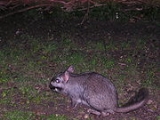
Plains Viscacha
Encyclopedia
The Plains Viscacha or plains vizcacha (Lagostomus maximus) is a species of rodent
in the Chinchillidae
family. It is the only living species within the genus Lagostomus
. It is found in Argentina
, Bolivia
, and Paraguay
. The plains viscacha is the largest species of the family Chinchillidae. They construct elaborate burrows that house successive colonies for
decades.
s, hindfeet with three toes.
systems in groups containing one or more male
s, several female
s and immatures. Viscachas forage in groups at night and aggregate underground during the day. All members of a group use burrows throughout the communal burrow system and participate in digging at the burrows. Alarm call
s are given primarily by adult males. The long-term social unit of the plains viscacha is the female group. Resident males disappear each year and new males join groups of females. Dominance is absent among females. Members of a social group share a common foraging area around the communal burrow system, and feed on a variety of grasses and forbs, occasionally browsing on low shrubs.
Plains viscacha ovulate
over 200 eggs per cycle (in comparison, humans usually only ovulate one egg per cycle).
Rodent
Rodentia is an order of mammals also known as rodents, characterised by two continuously growing incisors in the upper and lower jaws which must be kept short by gnawing....
in the Chinchillidae
Chinchillidae
The family Chinchillidae contains the chinchillas, viscachas, and their fossil relatives. They are restricted to southern and western South America, often in association with the Andes. They are large rodents, weighing from to , with strong hind legs and large ears...
family. It is the only living species within the genus Lagostomus
Lagostomus
Lagostomus is a South American genus of rodents in the family Chinchillidae. It contains a single living species, the plains viscacha, and it is the only recent genus in the subfamily Lagostominae....
. It is found in Argentina
Argentina
Argentina , officially the Argentine Republic , is the second largest country in South America by land area, after Brazil. It is constituted as a federation of 23 provinces and an autonomous city, Buenos Aires...
, Bolivia
Bolivia
Bolivia officially known as Plurinational State of Bolivia , is a landlocked country in central South America. It is the poorest country in South America...
, and Paraguay
Paraguay
Paraguay , officially the Republic of Paraguay , is a landlocked country in South America. It is bordered by Argentina to the south and southwest, Brazil to the east and northeast, and Bolivia to the northwest. Paraguay lies on both banks of the Paraguay River, which runs through the center of the...
. The plains viscacha is the largest species of the family Chinchillidae. They construct elaborate burrows that house successive colonies for
decades.
Appearance
Plains viscacha is a large rodent, weighing up to 9 kg. It has an average head and body length over 500 mm, with tail usually a little less than 200 mm long. The dorsal pelage ranges from gray to brown, depending upon soil color, and the belly is whitish. Its head is bulky, face is black and white, males have a distinctive black mustache and stiff whiskers. Forefeet are with four toeToe
Toes are the digits of the foot of a tetrapod. Animal species such as cats that walk on their toes are described as being digitigrade. Humans, and other animals that walk on the soles of their feet, are described as being plantigrade; unguligrade animals are those that walk on hooves at the tips of...
s, hindfeet with three toes.
Ecology and behaviour
They live in communal burrowBurrow
A burrow is a hole or tunnel dug into the ground by an animal to create a space suitable for habitation, temporary refuge, or as a byproduct of locomotion. Burrows provide a form of shelter against predation and exposure to the elements, so the burrowing way of life is quite popular among the...
systems in groups containing one or more male
Male
Male refers to the biological sex of an organism, or part of an organism, which produces small mobile gametes, called spermatozoa. Each spermatozoon can fuse with a larger female gamete or ovum, in the process of fertilization...
s, several female
Female
Female is the sex of an organism, or a part of an organism, which produces non-mobile ova .- Defining characteristics :The ova are defined as the larger gametes in a heterogamous reproduction system, while the smaller, usually motile gamete, the spermatozoon, is produced by the male...
s and immatures. Viscachas forage in groups at night and aggregate underground during the day. All members of a group use burrows throughout the communal burrow system and participate in digging at the burrows. Alarm call
Alarm call
In the field of animal communication, an alarm signal is an antipredator adaptation referring to various signals emitted by social animals in response to danger. Many primates and birds have elaborate alarm calls for warning conspecifics of approaching predators. For example, the characteristic...
s are given primarily by adult males. The long-term social unit of the plains viscacha is the female group. Resident males disappear each year and new males join groups of females. Dominance is absent among females. Members of a social group share a common foraging area around the communal burrow system, and feed on a variety of grasses and forbs, occasionally browsing on low shrubs.
Plains viscacha ovulate
Ovulation
Ovulation is the process in a female's menstrual cycle by which a mature ovarian follicle ruptures and discharges an ovum . Ovulation also occurs in the estrous cycle of other female mammals, which differs in many fundamental ways from the menstrual cycle...
over 200 eggs per cycle (in comparison, humans usually only ovulate one egg per cycle).

